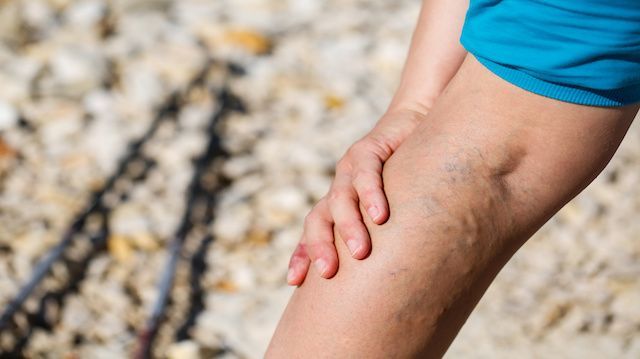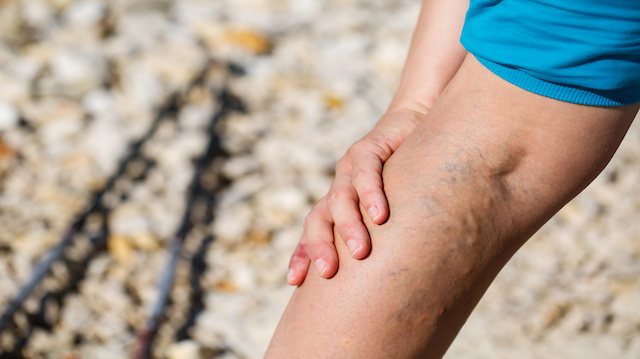
Varicose veins are a common problem affecting both men and women. They are essentially a damaged vein which then forms a visible mass, usually on the backs of the legs. Spider veins are a smaller form of the same problem, often having blue, red or greenish coloring and appearing anywhere on the body, including the face.
These veins are not only a source of embarrassment for people who wish to keep them hidden, but they can also cause physical discomfort. People with varicose veins may begin to feel a dull pain or heaviness in the legs, and may also experience cramps.
Some of the main causes of varicose veins include pregnancy (when the body’s blood volume increases by one fifth along with higher estrogen levels), chronic constipation (when pushing puts extra strain on the valves in the leg veins over time) and inactivity (due to a lack of blood-pumping support from the calf muscles).
The conventional treatment for varicose veins is sclerotherapy, which involves the injection of an inflammatory substance into the vein site. This causes the vein to shrivel and withdraw, so it is no longer visible. This procedure functions only as a spot treatment and does not prevent further unsightly and painful veins from arising.
Recent research from King’s College London has revealed that the traditional understanding of the formation of varicose veins is somewhat flawed.
It was believed that varicose veins occurred as a result of a failure of the valves on the ends of blood vessels, usually in the legs. When the small valve fails, blood pools in that area and the walls of the valve are distended into varicose veins.
Some people have better genes than others when it comes to this particular issue, so those with weak valve genes will inevitably end up with unsightly veins, end of story.
However, the new British research indicates that these genes can actually be turned on and off via an epigenetic process. This is where genes can be made to either exert an effect, or lie dormant, based on environmental and internal influences.
The researchers reported that the “weak valve” genes causing varicose veins can be turned off and the damage largely reversed by ensuring that there is more regular flow through the veins.
Therefore, it is important to incorporate the following preventative measures to turn off that varicose-vein promoting gene:
- Practice working or resting in different positions throughout the day, so that blood keeps moving and does not pool for several hours of the day. If you work in an office, this means standing often, walking around, sitting in a different position or in a different chair whenever possible.
- Spend five minutes each night with your legs straight up against a wall before going to bed. This is a very relaxing position that allows blood to drain from the legs so that the veins can recalibrate. It also helps relieve back and pelvic pain, and promote restful sleep.
- Rather than sitting for nine hours a day and then blasting your body at the gym for just one hour, try adjusting your schedule to fit in a few, shorter periods of exercise. This is a healthier pattern involving more constant or intermittent movement.
- Taking the blood flow and circulatory system from entirely stagnant to suddenly pumping at full capacity can actually damage blood vessels and contribute to varicose veins, and even blood clots and heart problems. Try gently raising your heart rate and circulation several times throughout the day, instead.
 Eating foods rich in fiber, vitamin C and bioflavonoids are a good choice for strengthening blood vessels. Examples are blueberries and raspberries.
Eating foods rich in fiber, vitamin C and bioflavonoids are a good choice for strengthening blood vessels. Examples are blueberries and raspberries.
- Essential oils on a cold compress applied to the skin can help soothe inflamed blood vessels and improve circulation. Good oils to use are cypress, lemon and bergamot. Herbal teas can also help with constipation.
- Savory and spicy foods such as ginger, garlic and cayenne pepper help to reduce blood clotting.
- Avocados are an excellent source of vitamin C, vitamin E and glutathione, a compound that protects tissues against oxidative damage.
- Flavoring your foods with rosemary can protect blood vessel integrity through its beneficial compounds ursolic acid and rosmarinic acid.
It’s easy to upgrade your diet and work in a little bit more movement throughout the day so that you can avoid unsightly varicose and spider veins. These healthy habits are sure to improve other parts of your life and well-being as well!
Try these quick workout ideas to get you moving.
—The Alternative Daily
Sources:
http://www.healwithfood.org/varicoseveins
http://onlinelibrary.wiley.com/doi/10.1002/bjs.1800810204/abstract
http://europepmc.org/abstract/med/3395496
http://jech.bmj.com/content/53/3/149.short
http://archsurg.jamanetwork.com/article.aspx?articleid=579837
http://www.mayoclinic.org/diseases-conditions/varicose-veins/basics/prevention/con-20043474
https://www.nhlbi.nih.gov/health/health-topics/topics/vv/prevention
http://www.webmd.com/skin-problems-and-treatments/tc/varicose-veins-prevention
http://www.nhs.uk/conditions/Varicose-veins/Pages/Whatarevaricoseveins.aspx

